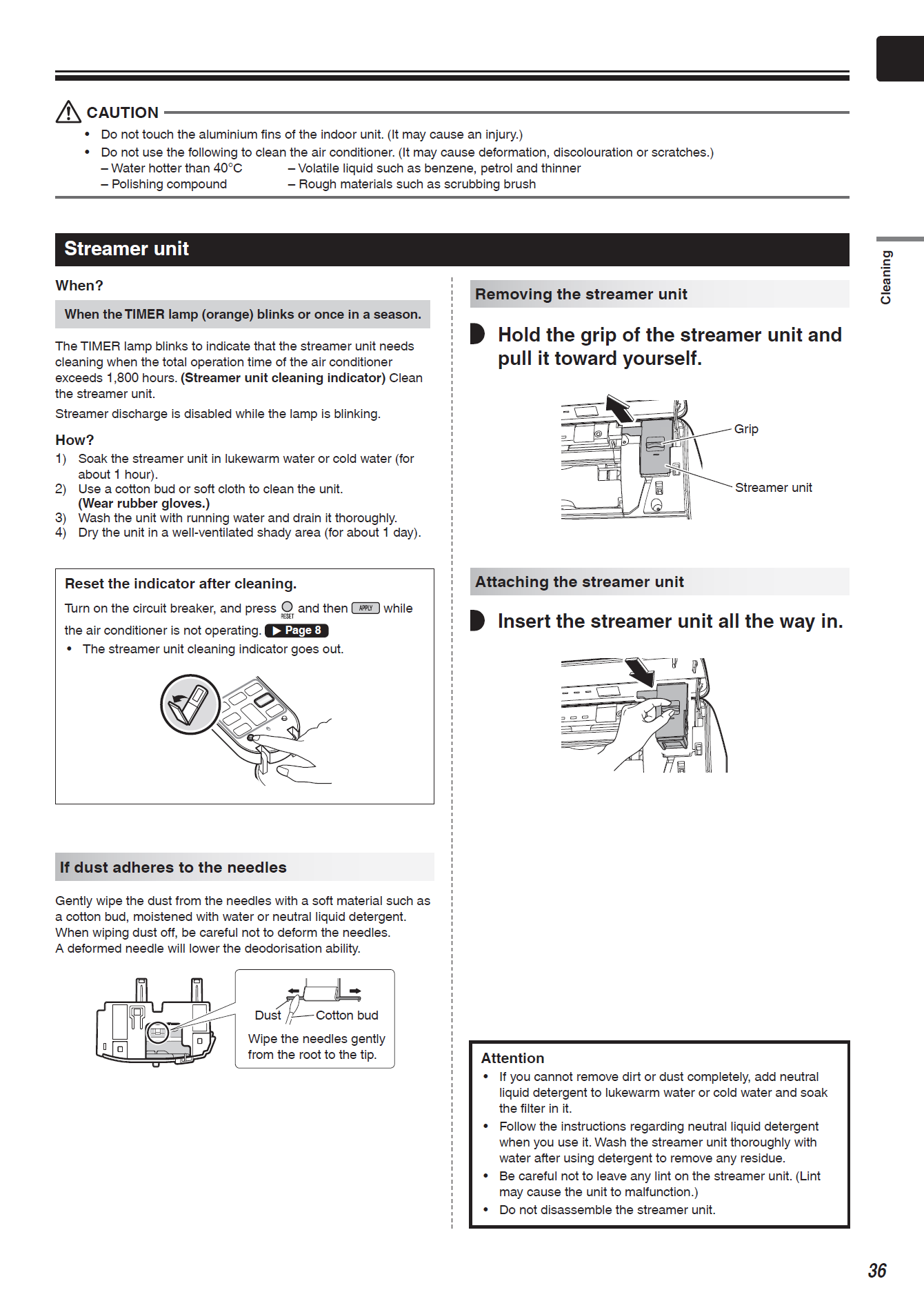FAQs
- My customer has a 1.5kW system installed with a third party inverter brand. If he wants to upgrade the system with a Fronius Primo 5 kW inverter in addition to the existing system, where the DNSP requires 5kW export limit, can this be done by using a Fron
Yes, if your export limit is equal to or greater than the other inverter’s output capacity this can be done. Please note: The Fronius Smart Meter will not control the power output of the third-party inverter. For example: If the third-party inverter is 1.5 kW and Fronius inverter is 5 kW and there is only 5 kW allowed to export, then the export limitation value that can be set on the Fronius inverter is 5 kW.
- Daikin US7 TIMER lamp (orange) keeps blinking?
If the Daikin US7 TIMER lamp (orange colour) appears to blink, this most likely indicates the streamer unit needs cleaning. This generally occurs when the US7 air conditioner has exceeded 1800 hours of total operation time.
When the lamp (orange colour) blinks, the streamer discharge is disabled.
The steps for cleaning the streamer unit in your Daikin US7:
- Soak the streamer unit in lukewarm water or cold water (for about 1 hour)
- Use a cotton bud or soft cloth to clean the unit (wear rubber gloves)
- Wash the unit with running water and drain it thoroughly
- Dry the unit in a well-ventilated shady area (for about 1 day)
Once complete, ensure to reset the indicator after cleaning. To do this:
- Turn on the circuit breaker
- Press "RESET" button (located bottom left corner underneath the control flap) and then press "APPLY" (located bottom right corner area under the controller flap) while the Daikin US7 is not operating
- The streamer unit cleaning indicator should no longer appear

- What are the benefits of the Daikin Ururu Sarara (US7) for home heating/cooling?
Efficient and cheap to run
The US7 heater air-conditioner is more than 600% efficient compared to direct electric systems and more than 900% efficient when compared to average existing gas ducted systems. To put it in different terms the unit uses 1/6 the energy of a conventional electric resistive heater and 1/9th the energy of an average existing gas ducted heating system to provide the same amount of heat to your home.
Less than 4 c/kWh, that's how much the popular 2.5kW (cooling) / 3.6kW (heating) US7 (model FTXZ25NV1B) will typically cost to run in an Australian household. If you combine it with a home solar system, which we recommend and are happy to supply, then it will cost even less - around 1-2 c/kWh to operate (based on Victorian average Powershop electricity rates).
Additional benefits of the US7
- Award-winning design: The US7 won the prestigious, 2013 reddot design award in the air conditioning category.

- Intelligent humidity control: Avoids dry air in winter and dehumidifies in summer.
- Fresh air, all year round: Ventilation and purification, guided by a motion-based intelligent eye, for fresh air when and where you need it.
- User-friendly control: Control it with a wireless remote control, via an app or as part of your home automation system.
- Energy Efficiency: The only unit to achieve a 7 star rating from the Federal Government. Thanks to advanced energy-saving technologies it uses 30% less energy than conventional split systems.
- Auto clean: The US7 automatically cleans its filters for up to 25% additional energy savings
- Award-winning design: The US7 won the prestigious, 2013 reddot design award in the air conditioning category.
- How do I size my Daikin US7?
To ensure you aren't under sizing or over sizing your Daikin US7, we generally like to get an idea of:
- Your ceiling insulation level.
- Which direction the windows face in the room you plan to put your US7.
- The floor area you want to heat in m2
- The total area of glass in the rooms you want to heat in m2 (i.e. the total size of all of your windows).
- Ratio of floor area to glass area.
- Individual window size.
These help us estimate your recommended heat or cool load to determine what size is required.
- Your ceiling insulation level.
- How is the Daikin US7 different to other home heating devices?
Firstly the US7 and other AC units can't really be compared one-for-one on efficiency alone. Most AC units are forced air heating devices while the Daikin US7 is a comfort solution. That's what sets it apart from all others along with being the lowest cost to run / lowest energy consuming air conditioner / heat pump on the market.
The reason it's so much better for comfort is that it includes a built in humidifcation unit valued at $500-1000 which harvests moisture from the outside air.
In addition it emits fresh air rather than recycled air so you can fill your house with fresh filtered air rather than progressively more stale air. Also, the way it distributes air by drawing from the top and bottom of the unit, as opposed to just the top, reduces air disturbance in the room (being blasted with warm air is not ideal).
Comfort = Air movement + humidity + temperature. Where Air movement should be slow (approximately 0.1 m/s), humidity is ideally 50% and temperature around 21 C °
So a major difference between the US7 and other AC units, apart from much greater efficiency, is the higher level of comfort (and fresher air) it creates in your home. - My Daikin Nexura is making noises - Should I be concerned?
Your Daikin Nexura will make certain noises as part of its normal operation (if you hear noises outside this list you may need to take action or contact your local AC mechanic):
The following is a list of noises you may hear that are not a cause for concern:
A sound like a flow of water:
- This sound is generated because the refrigerant in the air conditioner is flowing.
- A pumping sound of the water in the air conditioner it is heard when the water is pumped out from the air conditioner in cooling or drying operation.
- The refrigerant flows in the air conditioner even if the air conditioner is not working when the indoor units in other rooms are in operation, which may sound like a flow of water.
Blowing sound:
This sound is generated when the flow of the refrigerant in the air conditioner is switched over.
Pinging sound:
This sound is generated when the size of the air conditioner slightly expands or shrinks as a result of temperature changes.
Clicking sound during operation or idle time:
This sound is generated when the refrigerant control valves or the electrical parts operate.
Clopping sound:
This sound is heard from the inside of the air conditioner when the exhaust fan is activated while the room doors are closed. Open the window or turn off the exhaust fan.
- This sound is generated because the refrigerant in the air conditioner is flowing.
- The outdoor unit of my Daikin Nexura emits water or steam - Is this normal?
If your Daikin Nexura outdoor unit emits water or steam, here are some of the reasons this might be the case:
In HEAT or RADIANT operation
The frost on the outdoor unit melts into water or steam when the air conditioner is in defrost operation.
In COOL or DRY operation
Moisture in the air condenses into water on the cool surface of outdoor unit piping and drips.
- Daikin Nexura troubleshooting examples
The air conditioner stops generating air flow during operation.
Once the set temperature is reached, the airflow rate is reduced and operation is stopped in order to avoid generating cool airflow (during heating) or in order to keep the humidity from rising (during cooling). Operation will resume automatically when the indoor temperature rises or falls.
Unit does not start immediately when “ON/OFF” button was pressed, soon after operation was stopped or when a new mode is selected.
The delay in starting in these situations is to protect the air conditioner from wear and tear. You should wait for about 3 minutes before trying these options.
The HEAT operation stops suddenly and a flowing sound is heard.
The outdoor unit is taking away the frost. The HEAT operation starts after the frost on the outdoor unit is removed. You should wait for about 4 to 12 minutes.
The flap does not start swing immediately.
The air conditioner is adjusting the flap position. The flap will start moving soon.
The radiant panel surface temperature doesn't feel very hot
During RADIANT1 or RADIANT2 operation, the surface temperature of the panel will be about 55°C at maximum; this is the normal condition.
- Daikin Nexura care and cleaning quick reference
If you think your Daikin Nexura needs cleaning/maintenance, take a look below for do's and don'ts:
- Wait for a while before cleaning the unit after RADIANT operation. The surface temperature of the radiant panel may be high immediately after the operation.
- Before cleaning be sure to stop operation and turn the circuit breaker off (if unsure seek expert advice).
- Do not touch the aluminium fins of the indoor unit, they may be hot.
For cleaning, do not use any of the following materials:
- Hot water above 40°C.
- Benzine, gasoline, thinner, other volatile oils.
- Polishing compound.
- Scrubbing brushes, or hard bristles.
- Wait for a while before cleaning the unit after RADIANT operation. The surface temperature of the radiant panel may be high immediately after the operation.
- What are the benefits of the Daikin Nexura for home heating/cooling?
Benefits of the Daikin Nexura include:
- 500% efficient: The most efficient radiant heating heat pump in Australia.
- Can cool as well as heat: The Nexura is just like a reverse cycle AC; if you get hydronic heating, should you want to cool your house, you'll also need to buy air conditioners. The Daikin Nexura saves you this cost which can be up to $10,000 for a large home.
- No heating loop losses: Hydronic heaters lose up to 20% in their heat loop.
- Superior zoning: This allows you to heat or cool just the parts of the house you want to, saving you money on heating bills.
- Low thermal inertia: compared to hydronic, which takes up to 30 minutes to reach its nominal heat loop temperature.
- Lower running costs: Higher efficiency means lower energy bills.
- Standard servicing: Much cheaper to service than a conventional hydronic system.
- Radiant Mode: At the touch of a button, Nexura's aluminium front panel warms up just like a traditional radiator. The result is warmth from radiant heating, like from a fireplace, which many people prefer.
- Air Purification: Fitted with a titanium apatite deodorising air purification filter, that traps microscopic particles, decomposes odours and even deactivates bacteria.
- 500% efficient: The most efficient radiant heating heat pump in Australia.

